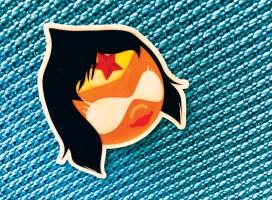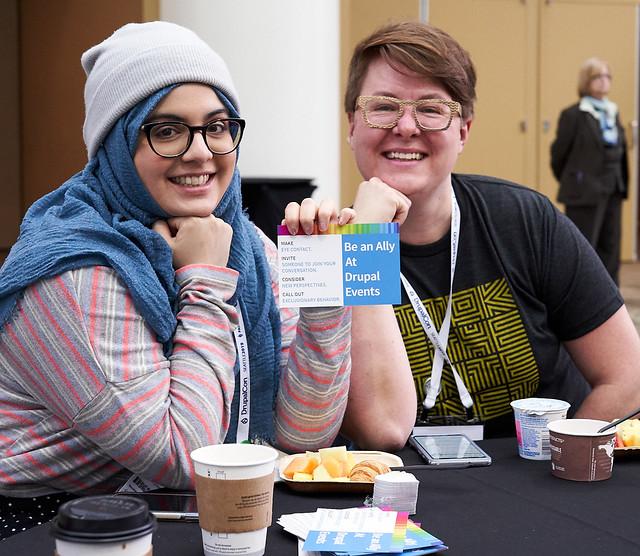The Women of the Drupal Community: lcatlett

Collection :
Previously in the Women of Drupal series, we interviewed Diana Wiener (diana.wiener) on the skill and confidence needed to deliver Drupal support to some of the world's largest global leaders. See how Diana stays cool, calm and collected in the face of natural disasters and national revolutions by reading the blog, here.
More than 1 million people have found a supportive and creative space to share their passion for technology in the Drupal community. Drupal is rooted in freedom and unites users from diverse backgrounds, professions and viewpoints. From content creators to developers to strategists, Drupal supports us all to do more with digital experience. This commitment to improvement is why we created Acquia's Women of Drupal blog series. We hope that by sharing these accomplishments, more women will feel empowered to get involved in tech and contribute to Drupal so that the open source environment continues to foster a wide range of perspectives and ideas.
As our community works towards equality in the technology sector, Acquia believes we can always be doing more to raise the voices of women who make an impact on the Drupal community every day. For more resources aimed toward helping women achieve in tech, the Women in Drupal group offers career guidance and opportunities to connect with other female Drupalists around the world.
- - - - - - - - -
For our latest look into the lives of the real Women of Drupal, I spoke with Lindsey Catlett, Drupal Architect and former Acquian, about teaching herself Drupal over a decade ago and becoming a team leader for many diverse product development efforts.
Lindsey's responses shined with admiration for how the Drupal community fosters participation and idea-sharing among every user. Read more for her tips on how to get started contributing and info on her upcoming session at DrupalCon Amsterdam 2019: “Women on Top: How to Get (and Keep) Women in your Leadership Roles.”
Paige: How did you get your start in tech?
Lindsey: I moved to Washington, DC to work on political campaigns after majoring in foreign affairs for undergrad at the University of Virginia; I actually got involved with tech by working in the “Howard Dean” era of Drupal in the 2004 and 2008 election cycles which essentially rewrote the political playbook on how candidates interacted with potential voters. I minored in computer science and while I enjoyed working on campaigns, I was always more excited and interested in the work candidates were doing online and with their web sites so I decided to transition into web development as my career instead of just an interest.
Paige: How did you first discover Drupal?
Lindsey: I’ve been involved with Drupal for over 10 years now - the nonprofit I was working for at the time I was first introduced in 2008 was migrating their static HTML site to Drupal and it fascinated me because it was something I could teach myself. I discovered drupal.org as well as local Drupal meet-ups in D.C. and was inspired by the technology as well as the community. I decided to make Drupal my “full-time” job about 8 years ago and went from building single sites as a developer to being the tech lead for larger sites, then went on to be the technical architect for multi-site platforms for nonprofit and government customers as a consultant and Acquia partner. I landed at Acquia as a technical architect in professional services in 2014 to deliver Drupal solutions for Acquia’s largest customers and went on to form the partner delivery enablement team to support Acquia’s partners to grow their Drupal and Acquia product development capabilities. I moved on from professional services to product as the product owner for Acquia Cloud Site Factory to enable product and engineering to leverage my background in enterprise Drupal and Acquia’s largest customers. Recently I joined Newell Brands as their Drupal Architect to lead their Drupal practice and it is incredibly rewarding for me to have the opportunity to lead a team excited about Drupal in a new environment.
Paige: What Drupal function, project or contribution are you working on and/or most proud of?
Lindsey: At Acquia, I had the opportunity to be a contributor and co-maintainer of BLT for a number of years and was able to contribute significant features for both Drupal multisite and Acquia Site Factory compatibility which are now the standard for customers to successfully use multisite with Drupal and Acquia products. Seeing various contributions evolve from a pull request to solve a specific customer problem to actually becoming part of a product speaks to the importance of contributing to open source in general, and especially to Acquia products in the case of BLT.
Paige: What are some challenges you've faced, technically or career-wise?
Lindsey: It goes without saying that imposter’s syndrome is common even among the most seasoned developers, and unfortunately tends to be more common in communities of underrepresented groups, so as a gay woman who is experienced in more senior technical roles I try to be as vocal as I can about my own struggles in my evolution from a junior engineer to senior architect in an attempt to both educate the community and encourage contributions from groups which may otherwise be discouraged from participating.

Paige: What inspires you? What keeps you passionate about your work?
Lindsey: The heart of most open source projects such as Drupal is rooted in open collaboration and community - for me - this also means that a pillar of my work is equity and enabling others to participate and contribute. The best projects and teams I have worked on have been able to transform organizations by keeping true to these principles which is motivating, inspiring and rewarding.
Paige: What are some other aspects of the Drupal community that you're involved in?
Lindsey: I am very privileged to work in roles and at organizations that encourage participation in open source and the Drupal community. I’ve had the opportunity to speak at Drupal conferences such as Drupal GovCon a number of times about platform building and multisite. While it can be difficult to make time for speaking at conferences and camps, it is always motivating to be at DrupalCon and talk to customers and users who are excited about Drupal. I’m particularly excited about presenting a session at the upcoming DrupalCon Amsterdam entitled: “Women on Top: How to Get (and Keep) Women in your Leadership Roles” with seasoned Drupalists Shannon Vettes and Jenn Sramek.
Paige: What does the future of Drupal look like in your opinion? More adoption, new features, any major changes?
Lindsey: Customers and users of Drupal are now evolving past needing to build single sites to deliver content, to building enterprise platforms which are the intersection of business and IT which speaks to not only the flexibility and power of Drupal, but its ability to transform nonprofit, government, and traditional corporate institutions and processes. I anticipate that this “platform mentality” will be a large part of Drupal’s future, as other content management framework pale in comparison since they focus primarily on the technical features rather than the combination of technology, people and process that Drupal brings.
Paige: What advice would you give your younger self or someone who is just starting out?
Lindsey: It can be intimidating putting in your first Pull Request or even filing an issue on drupal.org. The first time I put in a pull request to an open-source project, I probably reviewed it 100 times and checked the contribution guidelines 10 times. This happens to a lot of people, but in hindsight, I wish someone had told me that getting the PR in and attempting to contribute is more valuable and in many cases more important than having the PR be 100% correct. A good start to contributing is always documentation, and these contributions tend to be more straightforward and less intimidating. Most open source projects are always in need of better documentation. Contributing docs help you get used to both the workflow of that project, but also is very much appreciated by most maintainers!


